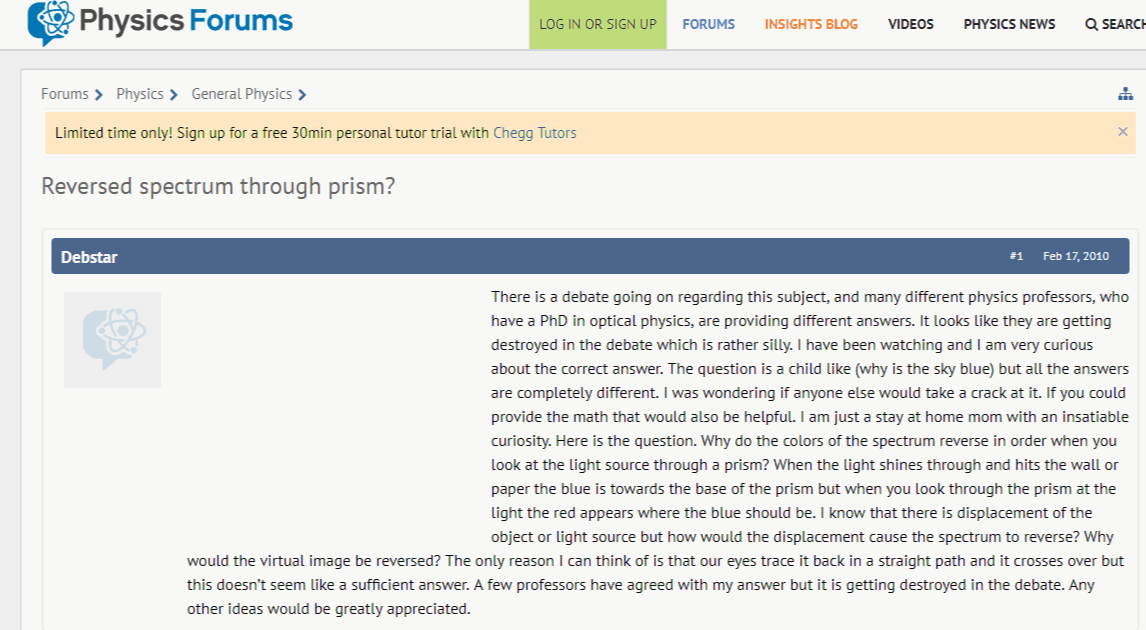On the colour dispersion of white light in my own universe
Let me begin this topic by reminding you first how the reigning conventional understanding depicts, visually, how a ray of white light is dispersed into the known colour display called the spectrum by a typical triangular prism.
These two visual depictions are described as being "conceptual", which I suppose is intended to suggest that they are only qualitatively representative of the phenomenon as such. The first of the two is conceptually depicting the conventional wave aspect of light, while the second is clearly concerned with the particle aspect of it. Both pictures are quite conspicuously displaying all the major conventional attributes of the light and dispersion phenomena. For instance from the particle version of the duo it is immediately apparent that, according to the conventional understanding, when travelling through a prism the speed of the red light is greater than those of all other spectral lights.
=============
A quick note to the ponderer.
If you want to get an accurate picture of where exactly our contemporaneous understanding in physics truly is my genuine advice is to forget consulting any online website that is associated with any official institution or similar representative (e.g. Wikipedia) and to direct your attention instead to fora like Physics Forums and Physics Stack Exchange. It is only in places like the two I mentioned where you'll be able to get a clear picture of the reality of our time in the subject of physics. As a concrete example that is directly related to our current topic click on this link and on this one.
=============
Now, let me make no bones about it, when it comes to the subject of how the conventional dogma describes what a ray of white light is and how it is dispersed by a prism into a spectrum I can (barely) manage to keep some sort of a straight face these days and pretend (to the best of my meagre abilities) to listen politely to those who are preaching the conventional view. To give you another concrete example that is directly related to this issue please have a good look at the 'pearls of wisdom' I extracted from this thread that took place in 2010 in the Physics Forums.
This was the question that started the thread and what you'll see below (if you haven't visited the link I gave above a moment ago) are some of the most prominent answers it attracted in reply.
Now, for those who don't know it I have to say that I have dealt with this particular thread in the past. But the truth is that when I did it (eight years back into the past, I think) I left a handful of things untouched, so today I am mending that misdeed of mine. Without any additional explanations, however. Not even in regards to why I have changed the "up" for the "left". See below.
There is no secret by now that according to my understanding the distribution of colours in the typical spectrum is well defined and ordered. This is naturally in total contrast to the view of the conventional understanding, which--apparently--looks something like this.
The four pictures above come from a You Tube video made by a high school teacher, I believe, in order to explain to her students, I guess, how refraction occurs in a triangular prism. Pretty wild, huh?
Nothing like that in my own understanding.
The picture above is meant to be looked at through a triangular prism (equilateral one, preferably) from a distance of about 1.5 m. (Prism should be oriented with its apex/vertex pointing to the left of the observer.) When such observation is conducted the three coloured bars vertically displayed on the right hand of the picture will merge, forming a ray of light (approximately) similar to the one shown horizontally. (Approximately because the coloured bars are dispersed by the prism into individual spectra themselves. Additionally, when blue refracts in a subjective prismatic observation on a black background it leaves behind a band of a dark green hue, which you can clearly see laying along the right side of the original trio.)
Now, those three bars (which are obviously coloured in the primary hues) are joining together along the same line because in all subjective prismatic observations Red is deflected towards the base of the prism, Blue towards the apex, while Green does not change its position at all.
And you can see the same law at work again if you next direct your attention to the horizontally placed ray of light (while continuing to look through your prism, of course). You know what I mean?
My ray of light is sufficient to account for light propagation, refraction, dispersion and diffraction as well, and all without any additional conditions. Now that is something that your conventional ray just cannot do, full stop. Do you dispute this fact, Markus Selmke? Or are you looking now at whether you should remind me or not that what I've done so far is to merely make declarations? Really, do I need to show you how easily beautifully easy all those things can be accomplished when my ray of light is employed?
Well, if I have to, I will. But not now. Next time, for now I want to show you instead another definitive proof that your so-called "well understood, quantified" theory of dispersion is flatly false. Have a look below.
Figured it out yet? No? OK, I'll show you some more pictures. And this time some of your own.
How about now? Still nothing? OK, but I'm afraid you'll have to wait until my next post, for now I have to go and see my little granddaughter--who, unlike you, is a real handful. Hooroo!































Comments
Post a Comment